Dmitry Baranchuk
MADrive: Memory-Augmented Driving Scene Modeling
Jun 26, 2025Abstract:Recent advances in scene reconstruction have pushed toward highly realistic modeling of autonomous driving (AD) environments using 3D Gaussian splatting. However, the resulting reconstructions remain closely tied to the original observations and struggle to support photorealistic synthesis of significantly altered or novel driving scenarios. This work introduces MADrive, a memory-augmented reconstruction framework designed to extend the capabilities of existing scene reconstruction methods by replacing observed vehicles with visually similar 3D assets retrieved from a large-scale external memory bank. Specifically, we release MAD-Cars, a curated dataset of ${\sim}70$K 360{\deg} car videos captured in the wild and present a retrieval module that finds the most similar car instances in the memory bank, reconstructs the corresponding 3D assets from video, and integrates them into the target scene through orientation alignment and relighting. The resulting replacements provide complete multi-view representations of vehicles in the scene, enabling photorealistic synthesis of substantially altered configurations, as demonstrated in our experiments. Project page: https://yandex-research.github.io/madrive/
Alchemist: Turning Public Text-to-Image Data into Generative Gold
May 25, 2025Abstract:Pre-training equips text-to-image (T2I) models with broad world knowledge, but this alone is often insufficient to achieve high aesthetic quality and alignment. Consequently, supervised fine-tuning (SFT) is crucial for further refinement. However, its effectiveness highly depends on the quality of the fine-tuning dataset. Existing public SFT datasets frequently target narrow domains (e.g., anime or specific art styles), and the creation of high-quality, general-purpose SFT datasets remains a significant challenge. Current curation methods are often costly and struggle to identify truly impactful samples. This challenge is further complicated by the scarcity of public general-purpose datasets, as leading models often rely on large, proprietary, and poorly documented internal data, hindering broader research progress. This paper introduces a novel methodology for creating general-purpose SFT datasets by leveraging a pre-trained generative model as an estimator of high-impact training samples. We apply this methodology to construct and release Alchemist, a compact (3,350 samples) yet highly effective SFT dataset. Experiments demonstrate that Alchemist substantially improves the generative quality of five public T2I models while preserving diversity and style. Additionally, we release the fine-tuned models' weights to the public.
CasTex: Cascaded Text-to-Texture Synthesis via Explicit Texture Maps and Physically-Based Shading
Apr 09, 2025Abstract:This work investigates text-to-texture synthesis using diffusion models to generate physically-based texture maps. We aim to achieve realistic model appearances under varying lighting conditions. A prominent solution for the task is score distillation sampling. It allows recovering a complex texture using gradient guidance given a differentiable rasterization and shading pipeline. However, in practice, the aforementioned solution in conjunction with the widespread latent diffusion models produces severe visual artifacts and requires additional regularization such as implicit texture parameterization. As a more direct alternative, we propose an approach using cascaded diffusion models for texture synthesis (CasTex). In our setup, score distillation sampling yields high-quality textures out-of-the box. In particular, we were able to omit implicit texture parameterization in favor of an explicit parameterization to improve the procedure. In the experiments, we show that our approach significantly outperforms state-of-the-art optimization-based solutions on public texture synthesis benchmarks.
Scale-wise Distillation of Diffusion Models
Mar 20, 2025



Abstract:We present SwD, a scale-wise distillation framework for diffusion models (DMs), which effectively employs next-scale prediction ideas for diffusion-based few-step generators. In more detail, SwD is inspired by the recent insights relating diffusion processes to the implicit spectral autoregression. We suppose that DMs can initiate generation at lower data resolutions and gradually upscale the samples at each denoising step without loss in performance while significantly reducing computational costs. SwD naturally integrates this idea into existing diffusion distillation methods based on distribution matching. Also, we enrich the family of distribution matching approaches by introducing a novel patch loss enforcing finer-grained similarity to the target distribution. When applied to state-of-the-art text-to-image diffusion models, SwD approaches the inference times of two full resolution steps and significantly outperforms the counterparts under the same computation budget, as evidenced by automated metrics and human preference studies.
Inverse Bridge Matching Distillation
Feb 03, 2025Abstract:Learning diffusion bridge models is easy; making them fast and practical is an art. Diffusion bridge models (DBMs) are a promising extension of diffusion models for applications in image-to-image translation. However, like many modern diffusion and flow models, DBMs suffer from the problem of slow inference. To address it, we propose a novel distillation technique based on the inverse bridge matching formulation and derive the tractable objective to solve it in practice. Unlike previously developed DBM distillation techniques, the proposed method can distill both conditional and unconditional types of DBMs, distill models in a one-step generator, and use only the corrupted images for training. We evaluate our approach for both conditional and unconditional types of bridge matching on a wide set of setups, including super-resolution, JPEG restoration, sketch-to-image, and other tasks, and show that our distillation technique allows us to accelerate the inference of DBMs from 4x to 100x and even provide better generation quality than used teacher model depending on particular setup.
Switti: Designing Scale-Wise Transformers for Text-to-Image Synthesis
Dec 03, 2024
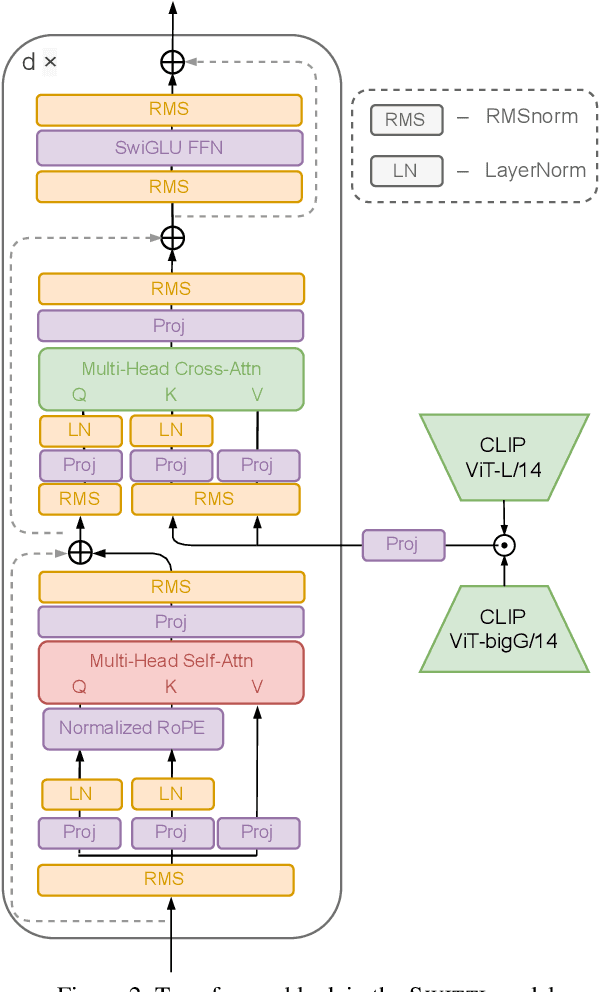

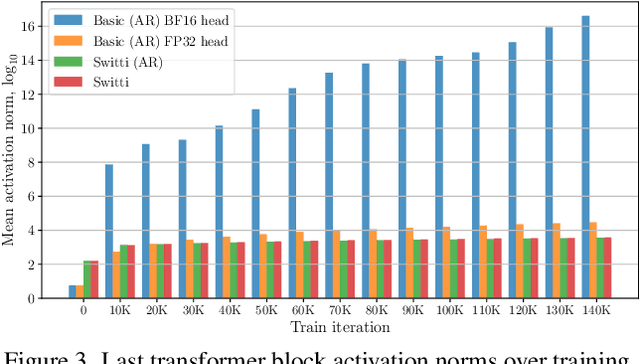
Abstract:This work presents Switti, a scale-wise transformer for text-to-image generation. Starting from existing next-scale prediction AR models, we first explore them for T2I generation and propose architectural modifications to improve their convergence and overall performance. We then observe that self-attention maps of our pretrained scale-wise AR model exhibit weak dependence on preceding scales. Based on this insight, we propose a non-AR counterpart facilitating ~11% faster sampling and lower memory usage while also achieving slightly better generation quality. Furthermore, we reveal that classifier-free guidance at high-resolution scales is often unnecessary and can even degrade performance. By disabling guidance at these scales, we achieve an additional sampling acceleration of ~20% and improve the generation of fine-grained details. Extensive human preference studies and automated evaluations show that Switti outperforms existing T2I AR models and competes with state-of-the-art T2I diffusion models while being up to 7 times faster.
Inverse Entropic Optimal Transport Solves Semi-supervised Learning via Data Likelihood Maximization
Oct 03, 2024



Abstract:Learning conditional distributions $\pi^*(\cdot|x)$ is a central problem in machine learning, which is typically approached via supervised methods with paired data $(x,y) \sim \pi^*$. However, acquiring paired data samples is often challenging, especially in problems such as domain translation. This necessitates the development of $\textit{semi-supervised}$ models that utilize both limited paired data and additional unpaired i.i.d. samples $x \sim \pi^*_x$ and $y \sim \pi^*_y$ from the marginal distributions. The usage of such combined data is complex and often relies on heuristic approaches. To tackle this issue, we propose a new learning paradigm that integrates both paired and unpaired data $\textbf{seamlessly}$ through the data likelihood maximization techniques. We demonstrate that our approach also connects intriguingly with inverse entropic optimal transport (OT). This finding allows us to apply recent advances in computational OT to establish a $\textbf{light}$ learning algorithm to get $\pi^*(\cdot|x)$. Furthermore, we demonstrate through empirical tests that our method effectively learns conditional distributions using paired and unpaired data simultaneously.
Results of the Big ANN: NeurIPS'23 competition
Sep 25, 2024
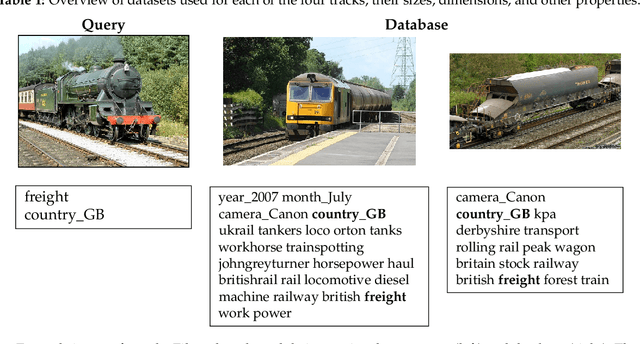
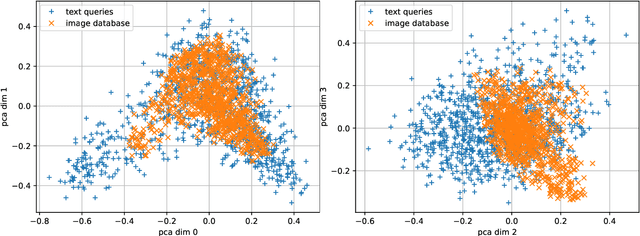

Abstract:The 2023 Big ANN Challenge, held at NeurIPS 2023, focused on advancing the state-of-the-art in indexing data structures and search algorithms for practical variants of Approximate Nearest Neighbor (ANN) search that reflect the growing complexity and diversity of workloads. Unlike prior challenges that emphasized scaling up classical ANN search ~\cite{DBLP:conf/nips/SimhadriWADBBCH21}, this competition addressed filtered search, out-of-distribution data, sparse and streaming variants of ANNS. Participants developed and submitted innovative solutions that were evaluated on new standard datasets with constrained computational resources. The results showcased significant improvements in search accuracy and efficiency over industry-standard baselines, with notable contributions from both academic and industrial teams. This paper summarizes the competition tracks, datasets, evaluation metrics, and the innovative approaches of the top-performing submissions, providing insights into the current advancements and future directions in the field of approximate nearest neighbor search.
Accurate Compression of Text-to-Image Diffusion Models via Vector Quantization
Aug 31, 2024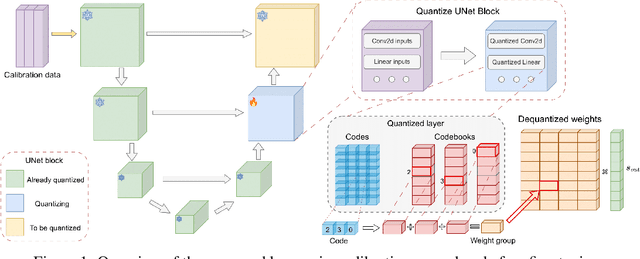
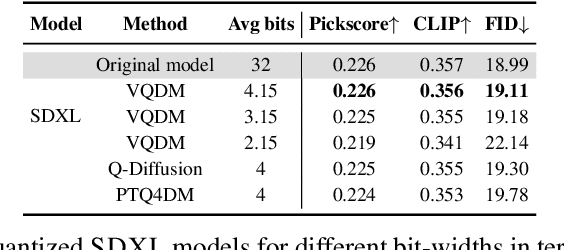


Abstract:Text-to-image diffusion models have emerged as a powerful framework for high-quality image generation given textual prompts. Their success has driven the rapid development of production-grade diffusion models that consistently increase in size and already contain billions of parameters. As a result, state-of-the-art text-to-image models are becoming less accessible in practice, especially in resource-limited environments. Post-training quantization (PTQ) tackles this issue by compressing the pretrained model weights into lower-bit representations. Recent diffusion quantization techniques primarily rely on uniform scalar quantization, providing decent performance for the models compressed to 4 bits. This work demonstrates that more versatile vector quantization (VQ) may achieve higher compression rates for large-scale text-to-image diffusion models. Specifically, we tailor vector-based PTQ methods to recent billion-scale text-to-image models (SDXL and SDXL-Turbo), and show that the diffusion models of 2B+ parameters compressed to around 3 bits using VQ exhibit the similar image quality and textual alignment as previous 4-bit compression techniques.
Invertible Consistency Distillation for Text-Guided Image Editing in Around 7 Steps
Jun 20, 2024
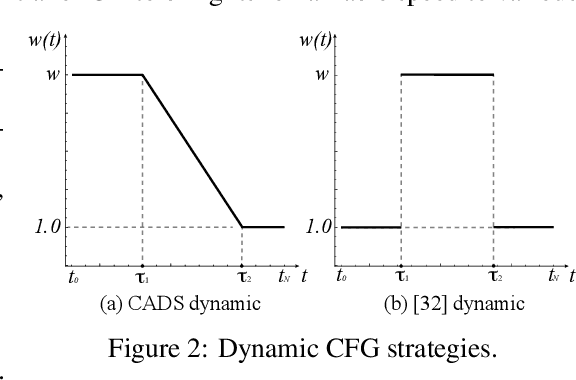


Abstract:Diffusion distillation represents a highly promising direction for achieving faithful text-to-image generation in a few sampling steps. However, despite recent successes, existing distilled models still do not provide the full spectrum of diffusion abilities, such as real image inversion, which enables many precise image manipulation methods. This work aims to enrich distilled text-to-image diffusion models with the ability to effectively encode real images into their latent space. To this end, we introduce invertible Consistency Distillation (iCD), a generalized consistency distillation framework that facilitates both high-quality image synthesis and accurate image encoding in only 3-4 inference steps. Though the inversion problem for text-to-image diffusion models gets exacerbated by high classifier-free guidance scales, we notice that dynamic guidance significantly reduces reconstruction errors without noticeable degradation in generation performance. As a result, we demonstrate that iCD equipped with dynamic guidance may serve as a highly effective tool for zero-shot text-guided image editing, competing with more expensive state-of-the-art alternatives.
 Add to Chrome
Add to Chrome Add to Firefox
Add to Firefox Add to Edge
Add to Edge